

Home - Women & the American Story. Activity Tools. Turn your students into historians with primary-source based activities.
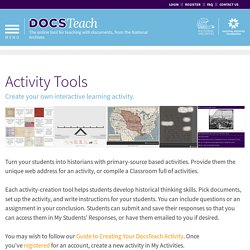
Provide them the unique web address for an activity, or compile a Classroom full of activities. Each activity-creation tool helps students develop historical thinking skills. Pick documents, set up the activity, and write instructions for your students. You can include questions or an assignment in your conclusion. Students can submit and save their responses so that you can access them in My Students' Responses, or have them emailed to you if desired. You may wish to follow our Guide to Creating Your DocsTeach Activity. Create a New Activity Analyzing Documents Teach students the process of document analysis, the foundation for working with primary sources. Focusing on Details: Discussion Topic Showcase one document while posing a question, comment, or directions for students. Focusing on Details: Spotlight Highlight a specific part of a document.
Focusing on Details: Zoom/Crop Focusing on Details: Compare and Contrast. Immigration to America: Part I.
Internet Archive Book Images' Photostream. Digital Docs in a Box. Introduction. The Massachusetts Historical Society holds many important manuscripts, photographs and artifacts that relate to the abolitionist movement in Boston.
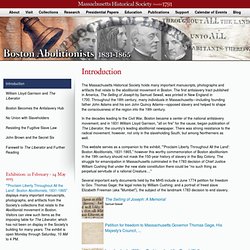
The first antislavery tract published in America, The Selling of Joseph by Samuel Sewall, was printed in New England in 1700. Throughout the 18th century, many individuals in Massachusetts—including founding father John Adams and his son John Quincy Adams—opposed slavery and helped to shape the consciousness of the region into the 19th century. In the decades leading to the Civil War, Boston became a center of the national antislavery movement, and in 1831 William Lloyd Garrison, "all on fire" for the cause, began publication of The Liberator, the country's leading abolitionist newspaper. There was strong resistance to the radical movement, however, not only in the slaveholding South, but among Northerners as well. Several important early documents held by the MHS include a June 1774 petition for freedom to Gov. Elizabeth Freeman ("Mumbet")
"I will be heard!" Abolitionism in America. Introduction Inspired by conscience and guided by principle, abolitionists took a moral stand against slavery that produced one of America’s greatest victories for democracy.
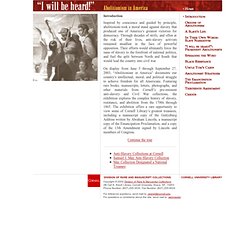
Through decades of strife, and often at the risk of their lives, anti-slavery activists remained steadfast in the face of powerful opposition. Their efforts would ultimately force the issue of slavery to the forefront of national politics, and fuel the split between North and South that would lead the country into civil war. On display from June 5 through September 27, 2003, “Abolitionism in America” documents our country’s intellectual, moral, and political struggle to achieve freedom for all Americans. Featuring rare books, manuscripts, letters, photographs, and other materials from Cornell’s pre-eminent anti-slavery and Civil War collections, the exhibition explores the complex history of slavery, resistance, and abolition from the 1700s through 1865.
The Gilder Lehrman Institute of American History. 11th Grade Social Studies.
Revolution to 1850. American Memory Learning Page. Designed to provide support for elementary, middle, and high school history teachers, this site makes the entire American Memory collection at the Library of Congress available for classroom learning.
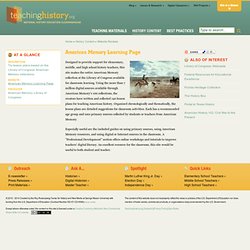
Using the more than 7 million digital sources available through American Memory's 100 collections, the creators have written and collected 140 lesson plans for teaching American history. Organized chronologically and thematically, the lesson plans are detailed suggestions for classroom activities. Each has a recommended age group and uses primary sources collected by students or teachers from American Memory. Especially useful are the included guides on using primary sources, using American Memory resources, and using digital or Internet sources in the classroom. A "Professional Development" section offers online workshops and tutorials to improve teachers' digital literacy. Teachinghistory.org. TeacherServe® from the National Humanities Center. Hands on History Library - America on the World Stage.
What's Race Got to Do with It? - TOOLBOX / Engagement Games. Click on the arrow next to each activity to read an expanded description (Javascript must be enabled) and see related discussion questions.
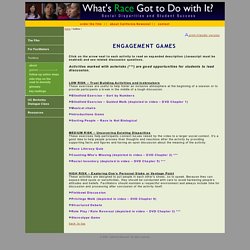
Activities marked with asterisks (***) are good opportunities for students to lead discussion. LOW RISK – Trust Building Activities and Icebreakers These exercises are useful to help foster an inclusive atmosphere at the beginning of a session or to provide participants a break in the middle of a tough discussion. Blindfold Exercise – Sort by Numbers This simple trust-building exercise works best with groups of 6-10 people. If you have more than 10 people, you can either ask for 10 volunteers to participate while the rest observe silently or divide everyone into small groups of 6-10 and conduct the exercise with one group at a time.
Ask everyone to spread out around the room and put blindfolds on. After they’ve finished the exercise, have everyone count off to confirm the proper order. Printable version of this activity Musical chairs Introductions Game.
Post WW2. General history visuals. Elections. Depression-New Deal. Civil War. Economics.